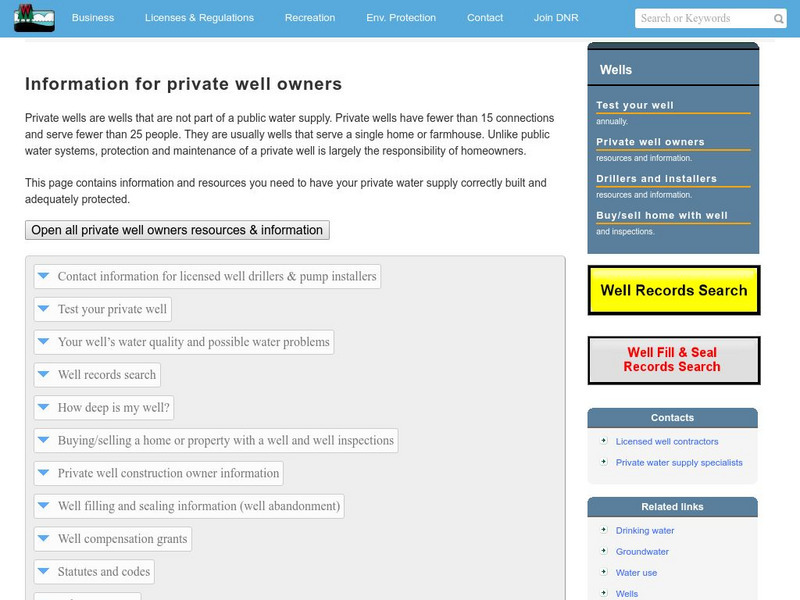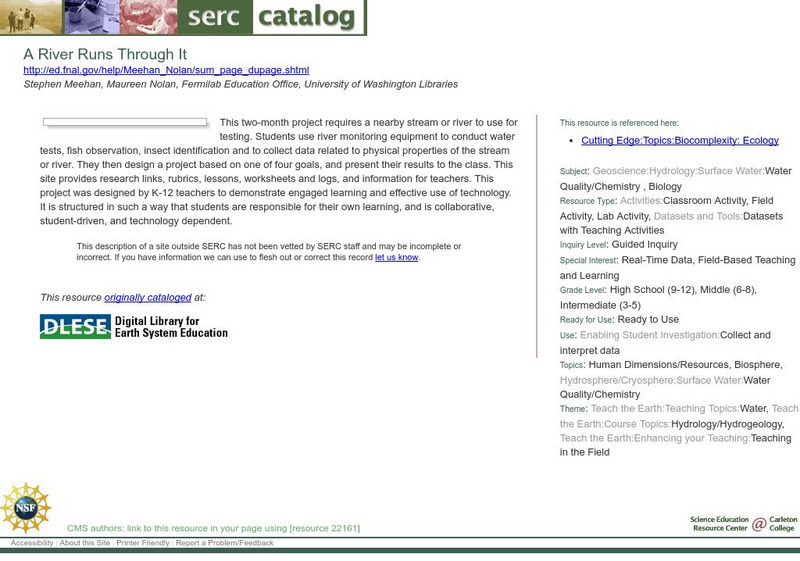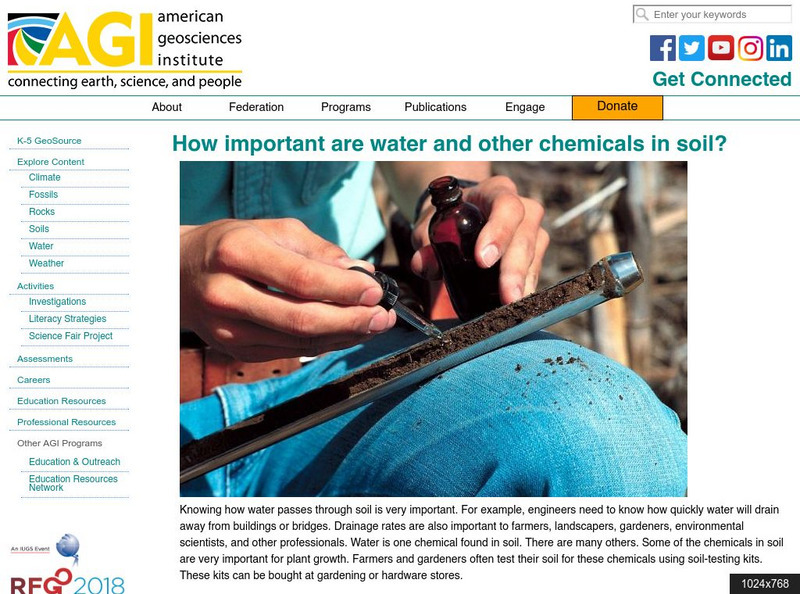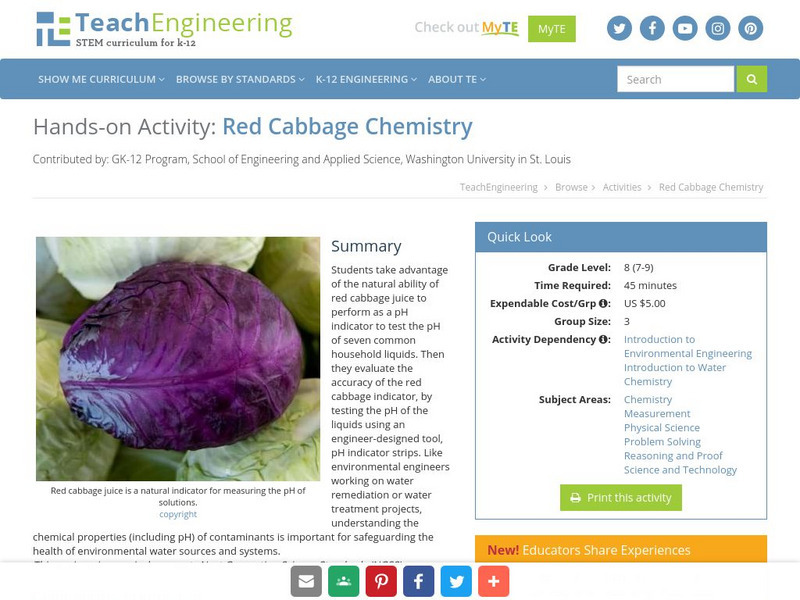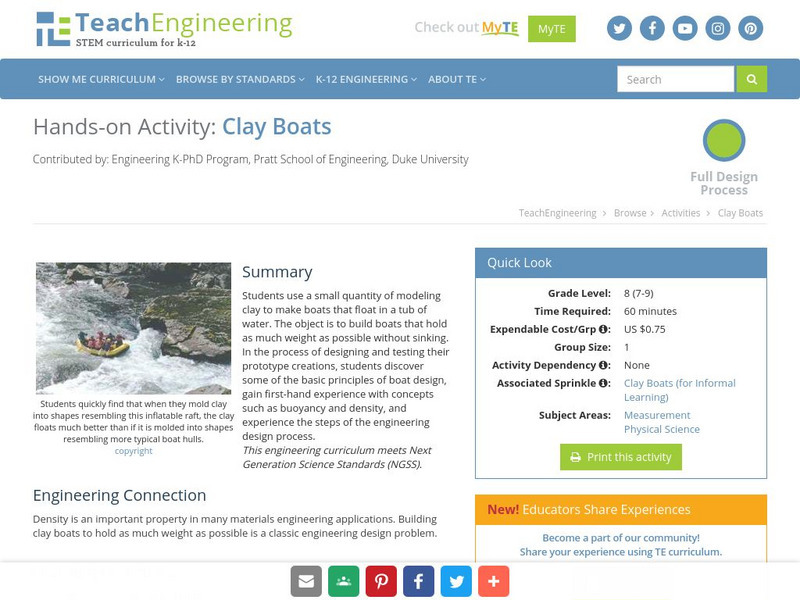Wisconsin Department of Natural Resources
Wdnr: Information for Homeowners With Private Wells
Provides information about water quality, contamination in private wells, well construction and pump installation for private wells, a list of laboratories certified to test for bacteria and other contaminants, recommendations for...
Science Education Resource Center at Carleton College
Serc: A River Runs Through It
This two-month project requires a nearby stream or river to use for testing. Students use river monitoring equipment to conduct water tests, fish observation, insect identification and to collect data related to physical properties of...
American Geosciences Institute
American Geosciences Institute: Water and Other Chemicals in Soil
Learn why scientists use testing kits to study the soil, and find out what chemicals they test.
EL Education
El Education: In the Zone: Where the Land Meets the Water
This field guide to the marine organisms of the intertidal zone of Casco Bay was created by 7th grade students in Portland, Maine, as part of a Learning Expedition called, "In the Zone." Students were engaged in scientific research at...
Other
Honolulu Community College: Galileo's Kinematics
In this experiment you will attempt to reproduce Galileo's results using the inclined plane. You will test three hypotheses relating to motion on an incline. You will learn to draw a "best fit" or regression line of experimental data....
Open Ed
Open Ed Sci: 7.2 Chemical Reactions & Energy
In this 21-day unit, students are introduced to the anchoring phenomenon-a flameless heater in a Meal, Ready-to-Eat (MRE) that provides hot food to people by just adding water. They complete investigations to collect evidence to support...
Omega Engineering
Technical Dissolved Oxygen: The Fundamentals
This site is useful to find information about dissolved oxygen and the types of tests that are administered to determine the dissolved oxygen level.
Science Education Resource Center at Carleton College
Serc: Investigating Starch in Foods
This lesson would be used during our nutrition unit when discussing carbohydrates. In this classroom activity students investigate which foods have starch in them by using iodine, as well as investigate the result of iodine and lemon...
Environmental Education for Kids
Eek!: Community Action & Citizen Science: Adopt a Beach
Learn about a program in Wisconsin called Adopt-a-Beach. Schools, families, businesses and community groups adopt beaches and shoreline areas in their local community to conduct litter removal and monitoring and water quality testing.
Other
National Science Digital Library: Smile: Aesop's Arithmetic
A cross-curricular activity integrating Aesop's The Crow and the Pitcher with an experiment testing the outcome of the fable using volume and displacement concepts.
Other
Basin: General Information on Alkalinity
This is a good informational site about Alkalinity. It gives a good explanation of it and some examples.
TeachEngineering
Teach Engineering: Reaction Exposed: The Big Chill!
Students investigate the endothermic reaction involving citric acid, sodium bicarbonate and water to produce carbon dioxide, water and sodium citrate. In the presence of water [H2O]; citric acid [C6H8O7] and sodium bicarbonate [NaHCO3]...
TeachEngineering
Teach Engineering: Red Cabbage Chemistry
Students take advantage of the natural ability of red cabbage juice to perform as a pH indicator to test the pH of seven common household liquids. Then they evaluate the accuracy of the red cabbage indicator, by testing the pH of the...
TeachEngineering
Teach Engineering: Materials Properties Make a Difference
Students investigate the materials properties-such as acoustical absorptivity, light reflectivity, thermal conductivity, hardness, and water resistancea-of various materials. They use sound, light and temperature sensors to collect data...
TeachEngineering
Teach Engineering: Energy Efficient Housing
We all know that it takes energy to provide us with the basics of shelter: heating, cooling, lighting, electricity, sanitation and cooking. To create energy-efficient housing that is practical for people to use every day requires...
Other
Covington Independent Public Schools: Grades K 2: It's Best For
Students will be testing different materials to see which is best suited for a particular task or quality: soaking up water, being flexible, and being abrasive. Each test can be done during a single class period.
TeachEngineering
Teach Engineering: The Need for Shelter
In this lesson, the students will build a shelter in order to protect themselves from the rain. After the shelters are built, the class will perform durability and water proof testing on the shelters.
Other
Dcm Process Control: Biological Oxygen Demand (Bod)
This is a resource that shows an example of biological oxygen demand.
Other
A More in Depth Look at Turbidity
A clear concise site that defines turbidity, states why it is important, discusses measuring turbidity, and lists natural and human factors that affect the turbidity of water.
Other
Lenntech: What Is Turbidity?
This informative site defines turbidity, lists its causes, addresses how much turbidity is allowed in drinking water, examines the consequences of high turbidity, and more.
TryEngineering
Try Engineering: Irrigation Ideas
The focus of this civil engineering lesson is on designing, building, and testing an irrigation system made from everyday materials to move water from one place to another.
TeachEngineering
Teach Engineering: Clay Boats
Each student uses a small quantity of modeling clay to make a boat that will float in a tub of water. The object is to build a boat that will hold as much weight as possible without sinking. In the process of designing and testing their...
Internet History Sourcebooks Project
Fordham University: Modern History Sourcebook: Lbj and Ho Chi Minh Letters
Two letters: one written by Lyndon Johnson (1908-1973 CE) to Ho Chi Minh and the other Minh's response. Johnson is testing the waters for a peace settlement while Minh insists that the Vietname War was provoked by the US and can only be...
EL Education
El Education: First Come the Eggs
First Come the Eggs, a picture book for young readers, was created by 3rd grade students in Rochester, New York. This is a biography of Seth Green, the father of fish hatcheries in America. The research included the study of the life...


